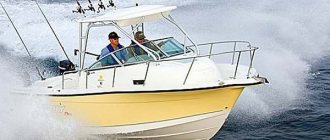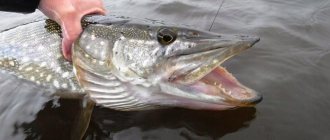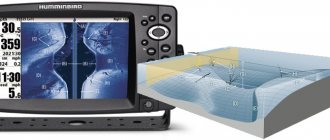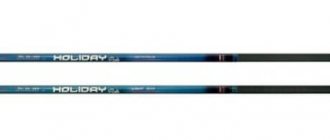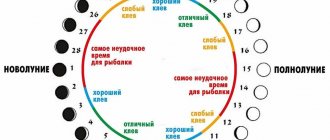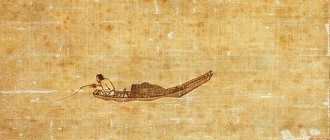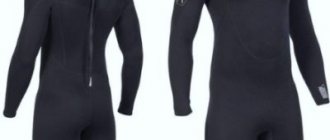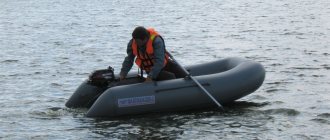Feeder fishing is incredibly popular. This tackle requires certain knowledge in the installation of equipment and in fishing itself. The fisherman needs to select all the components of such equipment. In this regard, the question inevitably arises: what is better - monofilament or braided line for the feeder?
There are fishing lines:
- monofilament;
- polyfibre;
- composite.
The basis of all fishing lines is synthetic materials - amide and nylon. Amide ones are more durable, less exposed to temperature, but do not fix knots well.
Nylon ones are weaker than amide ones, they absorb water and thereby increase their weight.
Polyfiber (braids) consist of many interwoven amide or nylon fibers. They are able to withstand heavy loads. For example, a braid with a diameter of 0.08 mm breaks at a weight of 3-5 kg. They are elastic, stronger at the knots. But their price is several times higher than the price of monofilaments.
The last time I ordered braided wire from Aliexpress. There are excellent models there for mere pennies!
Composite ones are monofilaments treated with a special protective layer. Thanks to this layer, the strength of the fishing line increases by 2 times. But at the same time, they are more rigid and damage the passage rings.
Read: Feeder equipment
Which is better - monofilament or braided line?
Some modern monofilament lines are no worse than braided lines, which is why some anglers prefer monofilament lines. Although sometimes it is not suitable for feeder fishing.
The main difference between braid and monofilament is the difference in sensitivity.
Wicker is practically inextensible and is capable of transmitting the weakest bites. The monofilament has stretchability, and at a long distance (25-35 m) the angler may not feel the bite.
If the bite is weak, using polyfiber there is a chance to come home with good trophies. On a long cast, to hook, it is enough to remove the rod from the stand, but with monofilament you still have to step back.
The disadvantage of braid is its ability to collect debris. She collects all possible trash in the water in the form of grass and fluff. Passage rings often become clogged.
But the advantages of polyfiber still surpass monofilament. For example, braid of the same diameter with monofilament is 3-4 times stronger. In fast water this is very noticeable. With a small diameter, less windage is obtained, and the feeder will be less likely to float with the current. Therefore, many experienced fishermen prefer braided line for feeder fishing.
Read: Feeder equipment for fishing in currents
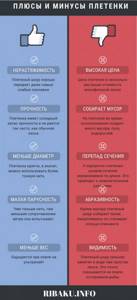
Tips for selection and application
Unlike the cord, the surface of the fishing line is smooth. The line glides better over ice-covered rings and does not freeze so much. For fishing in cold weather, most anglers choose fishing line. And this is one of the advantages in favor of monks.
The second undoubted plus, in this case, is the stretchability of the fishing line. It is recommended to place the line on the feeder when fishing in commercial reservoirs. There the main object of fishing is usually carp or large crucian carp. The use of fishing line here is more than justified. While fishing, the line stretches and softens the powerful jerks of the fish, acting as a shock absorber.
This helps to tire the desired trophy faster and avoid breaking the leash. Fishing on a platform usually does not require a long casting distance. On such fishing trips, the fish often bite actively and confidently take the bait. You don't necessarily need to have a sensitive base in the form of a braided cord. Place a fishing line and fish for your pleasure!
The price issue of choice is also important. Currently, the fishing industry offers a variety of monofilament and braided lines at the most affordable prices. Each angler can choose a fishing line or braid for a feeder according to his budget. It is worth noting that their quality has increased noticeably.
The existing price difference between fishing line and braid has disappeared. If earlier many people put fishing line on the feeder because of its low price, now every angler should be guided in choosing the basis for the feeder solely by the fishing conditions, his preferences and experience.
The selection is made based on the criteria outlined above. For beginners, we will give some important tips:
- There is absolutely no need to chase the price. For many years, representatives of the younger generation have formed a stereotype: “The more expensive the product, the better its quality.” This statement is not always true;
- of course, it is better to give preference to products from well-known brands, whose fishing products, in particular braided fishing line, have already proven themselves well;
- A low-quality thread is determined by the presence of a large number of protruding hairs, even when you just bought it or only use it for a short time. Sometimes they can be seen with the naked eye; the presence of such a defect means that the cord frays very quickly and will let the fisherman down at the most inconvenient moment;
- It is not recommended to use thicker ordinary braid when making a shock leader for a feeder. The best option is to purchase a genuine wicker “shock” with the appropriate inscription on the packaging, designed specifically for such needs;
- a good braided line should sink quickly in water, this is also one of the most important identifiers of high quality;
- Still, low-quality cords (or fakes) are detected when the paint peels off from them after a couple of fishing trips.
We invite you to familiarize yourself with: Echo sounder for winter fishing through ice: recommendations on how to choose the best wireless portable fishing device for winter (photos and videos)
IMPORTANT! Many people write that the rustling of braids in rings is a negative thing. No, in fact, this happens, and this is not a defect; rustling fishing lines have no effect on the quality of fishing.
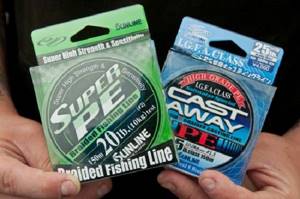
Take a closer look at the left box. LB and CG are indicated, which is why we gave the table (deviations in indicators are, as a rule, not critical), because not every manufacturer writes both.
Leash on feeder tackle
- winter feeder Braided threads absorb water, which freezes in the cold, as a result the cord as a whole becomes brittle;
- braids withstand shell rocks much worse. Shell valves, for example, the toothless one, can quickly cut such a fishing line;
- The use of braided cords also causes a lot of trouble on reservoirs whose bottom is heavily littered. Because of the texture, the specks get stuck and then remain in rings – you have to clean them out every time;
- The elongation of the cord is almost zero - it is not suitable for catching very large (namely very large) inhabitants, it can break, but the braids give the tackle high sensitivity. You can feel even a weak bite 70 meters away;
- The line will fray at the cut points, it is recommended to burn the tip a little at once and straighten it with your fingers.
How to choose braid for a feeder
The choice of braid for the feeder depends on the fishing location. If you have to cast the feeder over short distances, then monofilament may be suitable.
Read: Line for feeder
But if the angler plans to catch large fish, then a polyfiber cord for the feeder is required. Large individuals rarely approach the shore, so casting the feeder will be a considerable distance.
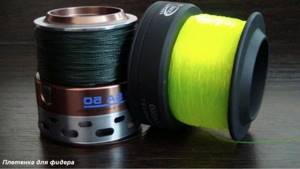
Color plays a significant role when choosing fishing line. Since feeder fishing occurs at good depths, it is better to choose dark colors.
It is advisable to familiarize yourself with the fishing location. If the water is light and clean, then you need to take light blue cords. Green is suitable for places with dense aquatic vegetation. But some fishermen choose light shades: this makes it more convenient to control the landing of fish, especially in snag areas.
A good braid should:
- having a smooth surface will have a positive effect on increasing casting distance;
- be dense and not swell in water;
- to sink immediately;
- be long, approximately 150 m.
When choosing the breaking value for a braided line on a feeder, you must remember that in water this load will decrease by 20%. It is necessary to take into account both the weight of the entire feeder and the casting distance. If you throw a feeder weighing 100 grams over 40 m, then a braided line with a breaking force of up to 5 kg will do. But if you increase the distance, then this figure should be 6-7 kg.
You can reduce the load on the fishing line using a feeder.
Read: Fidergam
When choosing polyfiber for a feeder by diameter, you should not pay special attention to this value. 0.08−0.15 mm will do. The thinnest cords are useful in fast currents. On the lake, thicker ones are suitable, suitable for casting heavy feeders.
The feeder cord must be examined visually when purchasing. It should not be shaggy, frayed or unevenly colored, and should be perfectly round in cross-section along its entire length. This will prevent the polyfiber from becoming tangled.
A high price is no longer an indicator of high quality. Some cheap options are as good as Power Pro or FireLine.
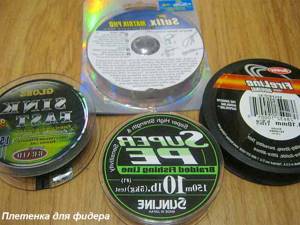
You can buy several meters of fishing line from an unknown manufacturer and use it as leashes.
Rating of braided lines based on reviews from fishermen:
- Daiwa Regal Sensor (5−7.5 kg), black, no stretch. The wicker is shaggy;
- Daiwa TD-Sensor Tournament - 15 lb, made of 8 threads. Suitable for 100g feeder, completely smooth and round. When tying knots, they must be wetted;
- Sufix Matrix PRO is a reliable braided cord that lasts for several seasons; inexpensive class.
- Sufix 832 Braid Lo Vis Green - made of 8 veins. Great strength, does not make noise when passing through the rings. The line is soft.
- Sunline Super PE - for catching all types of fish. It loses its properties quickly and becomes shaggy.
- Sunline Cast Away PE - for catching any fish. The composition includes 8 threads, sinks and spreads a little into the veins.
Length
Most anglers tend to buy small line reels. The arguments in favor of this are that if you are fishing at a distance of up to 60 meters, then a cord 100 meters long is more than enough. This is not entirely true. The fact is that during the season you have to tear off a significant amount of cord at hooks and loops. Usually the caught feeder and somewhere up to 10 meters of the cord above it breaks. The probability of a break is even higher, but usually it occurs in the most worn-out area, and this is the first ten meters. If the loops break, the feeder remains intact, unless it was shot while casting, but the piece of cord from the very loops to it will have to be thrown out entirely. When caught with the “shock leader”, the entire “shock leader” and a piece of cord about 5-6 meters long usually breaks off.
It is worth taking into account the number of fishing trips carried out per year, the average casting distance (for a feeder - about 40 meters, for a picker - about 20), and also the fact that during fishing there will be at least one hook with a cliff of 10 meters. As a result, it turns out that a hundred-meter cord is enough for 5-6 fishing trips with a feeder, which is not much. The best option for those who don’t go fishing very often would be to install a braided line with a 200-meter unwinding distance. It will last for a year or more. When it wears out in the front part, you can fish for a while longer by simply winding it onto the reel spool backwards.
If you go fishing often, and the fishing is carried out at extremely long distances, then it is advisable to take the lines in a special unwind of 500 meters. The reel spool here must be of appropriate capacity. Usually, for a cord of 200 meters, any spool is too large and requires winding up a certain amount of backing. The backing should be selected so that approximately 1-1.5 mm remains to the edge of the spool, then the cast will be as far as possible, and the likelihood of loops falling off will be small.
The best braided cords for feeders in store ratings
- Power Phantom 4x - made of polyethylene, the latest generation of SUPER PE cords. It has the following characteristics: a completely circular cross-section, constant diameter along the entire length. Due to its ideal smoothness, it is able to throw the feeder over a long distance. Completely devoid of memory, this is an important property for weak bites. Can be used at sub-zero temperatures. Excellent for feeder fishing.
- DAIWA REGAL SENSOR - many threads woven and impregnated into a cord. Has very little stretch. It should be chosen instead of others that are larger in diameter. Its use increases the casting range of the feeder. It is not advisable to use in areas with shell rock.
- Benkei 8-X - consists of 8 polyethylene cores, which in turn consist of even smaller PET fibers. Strong weave, has a very slippery surface. You can cast the feeder over a long distance.
- An excellent durable braided cord is Power Pro Moss Green. This American cord is made from Spectra Fiber. It is highly resistant to abrasion, highly elastic, inextensible, and has no memory. The knots tied are strong. Capable of decent feeder feeds.
Review of Allvega Feeder Braid with a diameter of 0.12mm
Also a very worthy braid. The reel length is 150m, which will allow you to fish for at least two seasons. The 4-core structure is noisy on the rings, but provides the necessary strength when fishing with a feeder.
Advantages of Allvega Feeder Braid:
- the price is low, considering the durability;
- good wear resistance, resistance to friction and cuts. But it won’t hurt to cut 1-3m of the cord after fishing.
Disadvantages of Allvega Feeder Braid:
- slight noise when rubbing against the rings;
- Some of the paint peels off during the first fishing trip, but subsequently the paint washes off very slowly.
At the end of the season, the braid can be rewound backwards. So the load will fall on the end that practically did not participate in casting last season.
Review video
